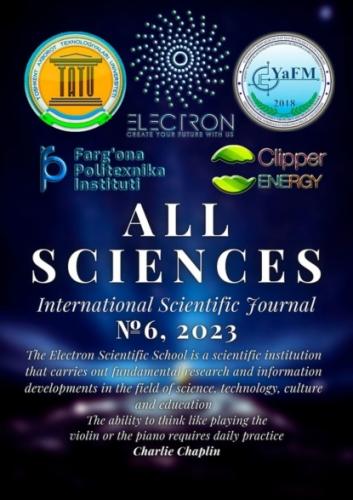International Scientific Journal
Editor-in-Chief Ibratjon Xatamovich Aliyev
Illustrator Ibratjon Xatamovich Aliyev
Illustrator Obbozjon Xokimovich Qo'ldashov
Illustrator Sultonali Mukaramovich Abduraxmonov
Cover design Ibratjon Xatamovich Aliyev
Cover design Ra'noxon Mukaramovna Aliyeva
Acting Scientific Supervisor Sultonali Mukaramovich Abduraxmonov
Economic Manager Farruh Murodjonovich Sharofutdinov
Economic Consultant Botirali Rustamovich Jalolov
Proofreader Gulnoza Muxtarovna Sobirova
Proofreader Abdurasul Abdusoliyevich Ergashev
Proofreader Ekaterina Aleksandrovna Vavilova
ISBN 978-5-0060-5771-5 (т. 6)
ISBN 978-5-0059-5900-3
Создано в интеллектуальной издательской системе Ridero
PHYSICAL AND MATHEMATICAL SCIENCES
QUESTIONS CONCERNING THE SPECTRAL SOLUTION IN A ONE-DIMENSIONAL STATIONARY LINEAR PARTIAL DIFFERENTIAL EQUATION BY ERWIN RUDOLF JOSEF ALEXANDER SCHRODINGER
UDC 150.145
Nasriddinov Otadavlat Usubzhonovich
Senior Lecturer of the Department of «Natural Sciences» of the Faculty of Computer Engineering of the Ferghana branch of the Tashkent University of Information Technologies
Ferghana Branch of Tashkent University of Information Technologies, Ferghana, Uzbekistan
Annotation. The impossibility of intuitive understanding of the most diverse spectrum of quantum phenomena reduces to the need to use all physical and mathematical methods before all empirical and experimental actions. One of the most popular and important in this vein is a linear partial differential equation describing the change in space and time of the pure state, given by the wave function, in Hamiltonian quantum systems for photonic phenomena expressed in a stationary state.
Keywords: Schrodinger equation, stationary state, spectral problems, quantization, differential equation, physical and mathematical calculation and modeling.
Аннотация. Невозможность интуитивного понимания самого различного спектра квантовых явлений сводит к необходимости использования перед всеми эмпирическими и экспериментальными действиями всех физико-математических методов. Одним из самым популярным и важных в данном ключе является линейное дифференциальное уравнение в частных производных, описывающее изменение в пространстве и во времени чистого состояния, задаваемое волновой функцией, в гамильтоновых квантовых системах для фотонных явлений выражаемое в стационарном состоянии.
Ключевые слова: уравнение Шрёдингера, стационарное состояние, спектральные задачи, квантование, дифференциальное уравнение, физико-математическое вычисление и моделирование.
Before presenting the question itself, it is worth noting the representation of the one-dimensional stationary Schrodinger equation itself, which is a linear ordinary differential equation of the second order (1), which is also used to solve problems of the spectral plan in wave modeling of photonic phenomena.
In order to solve such an approach, it is necessary to introduce boundary conditions (2), depending on the formulation of which it is possible to determine a general description of the situation and at the same time pay attention to the statement of indicators (3).
Of course, one could try to determine a general solution, but, unfortunately, this is simply impossible and it is necessary to introduce certain boundary conditions that are reduced from certain conditions. A striking example of such states is the solution for a free particle, which is essentially a plane wave. And if we take the potential equation for a free particle, including when taking the corpuscular form of photons, we can get equation (4).
One of the partial solutions is the function (5), derived through a direct solution of a second-order differential equation.
In (4), the constant E can take almost all values above zero, it is from here that we can conclude that the values belong to a continuous spectrum. Moreover, to determine its boundaries, it is necessary to use the integral equation (6), from which the resulting constant C from (5) is obtained.
Hence the value (7) is obtained.
And finally, by substitution, it is possible to obtain a solution of equation (4), for the case of a free particle, which, including, in wave calculus, is a superposition of plane waves (9).
But if this was only one of the special cases, then it is worth considering the case of being in a one-dimensional potential pit with infinitely high walls. After all, if you pay attention to the representations of this question, then it may well be a reducible case in the face of the entry of a photon into a particular atom, provided it approaches the electron shells, the exit from which can play the role of infinitely high walls of a potential well. Also, another larger-scale macro example is the approach of photon radiation to a black hole. For such cases and intervals, the Schrodinger equation coincides with the representation according to (4), from where the boundary conditions for the wave function, previously designated algebraically (2), are represented as (10—11).
The solution, as it was possible to draw attention from other particular solutions, can be reduced to the form (12).
But if we now introduce boundary forms for this type, we can come to a solution of the energy index as (13).
Finally, now it remains only to introduce its own functions, along with the general normalization, and obtain the resulting solution (14).
Thus, some of the partial solutions of the linear Schrodinger equation were considered, each of which can be interpreted in the face of a solution of one kind or another, the number of which can be huge.
Used literature
1. Allday Jonathan. Quantum Reality: Theory and Philosophy. 2nd edition. –
